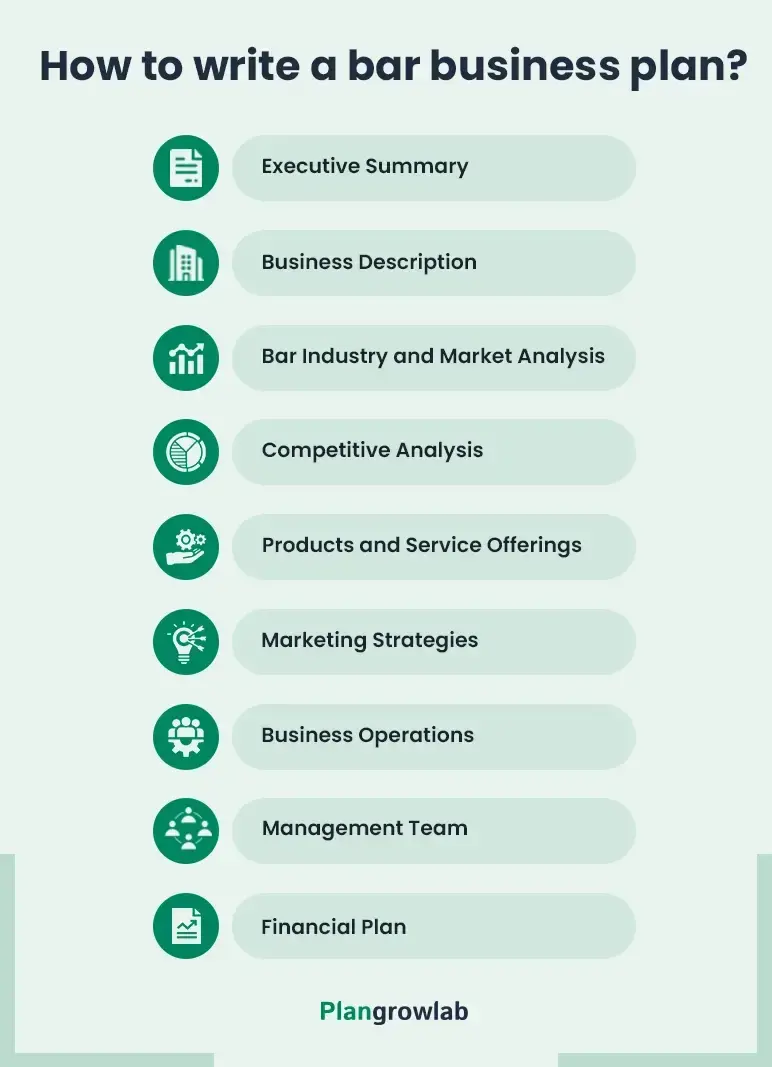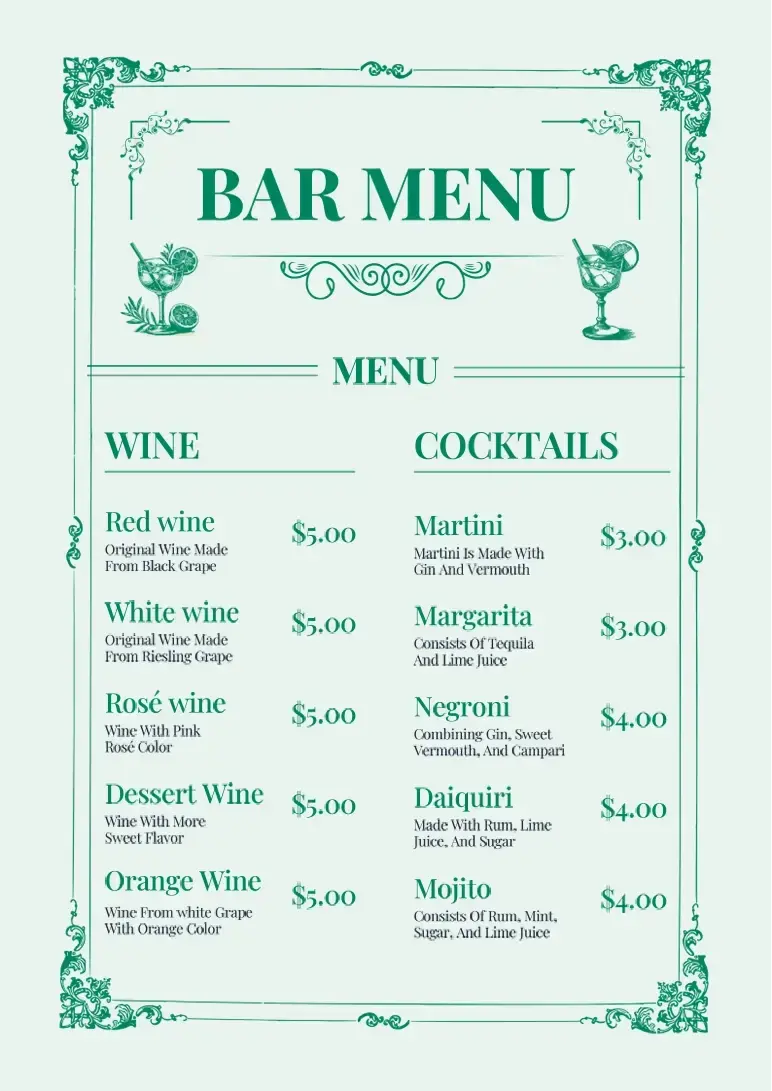Imagine you’ve got the perfect name for your bar, a vision for the ambiance, and drinks people can’t stop talking about. Exciting, right?
But to turn that dream into a successful business, you need a solid business plan. That’s exactly what Stephanie Cacioppo, the owner of “The Spot Espresso Bar & Cafe”, discovered when she set out to build her business.
I recently talked to her about how a business plan helped her and what challenges she faced along the way.
From those insights, I’ve prepared this guide to help you create a bar business plan that works best for you.
Why do you need a business plan for your bar?
Let’s be honest—opening a bar isn’t just about serving drinks and creating a fun vibe. It’s also about making smart decisions and staying organized. That’s where a business plan comes in.
Here are a few reasons why a business plan matters:
- Gives you direction: Helps you figure out your bar’s vibe, what you’ll serve, and who you’re trying to attract.
- Prepares for costs: Makes it easier to plan for costs like setup, stock, and staff—no surprises later.
- Keeps marketing on track: Gives you a clear way to get people in the door and keep them coming back.
- Identifies challenges early: Spots potential problems and helps you plan solutions before they hit.
- Attracts potential investors: Shows lenders you’ve got a real strategy—not just an idea.
At the end of the day, opening a bar without a plan is like mixing drinks without measuring—things can get messy fast.
How to write a bar business plan?
Creating a bar business plan is all about laying out your ideas, goals, and strategies in a clear, organized manner. Here’s a simple guide to help you put it together step by step.

1. Executive Summary
The executive summary is the highlight of your bar business plan—a quick overview to grab attention and spark interest.
To plan this section, start with your concept—whether it’s a cozy pub, upscale cocktail lounge, or lively sports bar—and describe the vibe and what makes it unique.
Add a mission statement that reflects your vision, like creating a go-to spot for celebrations or casual drinks. Outline your goals, such as attracting a set number of customers, hitting revenue targets, or future expansion plans.
Finally, mention your financial projections in brief and reflect on how much funding you’ll need to bring your bar vision to life.
"Writing the executive summary for my bar business plan was all about setting the tone and making an impact right away.
The challenge was keeping it short but still explaining what makes my bar different—its theme, atmosphere, and unique drink menu.
I focused on highlighting the location, target audience, and growth potential. After a few drafts, it felt sharp and gave a clear snapshot of my vision and goals."—Stephanie
2. Business Description
This section is all about painting a clear picture of your bar.
Start with your concept—what kind of bar are you opening? Is it laid-back and casual, a little more upscale, or all about craft drinks? Make it easy for readers to imagine stepping inside.
Then, talk about where it’s located and why that spot works. Is it downtown? Near offices? In a lively neighborhood? Mention anything that makes the space stand out, like outdoor seating, a space for private events, or a cool central bar setup.
Also, share a little backstory—what inspired you to start this bar? Maybe you saw a gap in the target market or wanted to bring a new experience to your community.
End with details about the ownership structure and key players who will help bring your vision to life.
"The business description pushed me to define my bar’s identity. It wasn’t just about serving drinks—it was about creating an experience.
The hardest part was explaining my concept in a way that felt exciting but still realistic. I focused on my bar’s vibe, target customers, and mission.—Stephanie
3. Bar Industry and Market Analysis
Before opening a bar, it’s important to understand the industry. This will give you or potential investors valuable insights into the emerging trends, target market, and customer segments.
Here’s a list of key elements that you must research and include in this section:
- Industry trends – Highlight popular trends like craft cocktails, themed bars, or Instagram-worthy spots that match your concept.
- Market growth – Show if the industry is growing and how people are spending more on social experiences. Add data if possible.
- Target customers – Identify your audience—young professionals, event groups, or casual hangouts.
Moreover, you can build a quick profile of your ideal customer to understand who you're trying to attract. Think about their age, lifestyle, how much they usually spend, and what kind of experience they expect when they walk into a bar like yours.

Be specific about what they value—good service, creative drinks, or a cozy atmosphere. Break the target market into segments, like weekday office crowds and weekend partygoers, and explain how your bar caters to each group.
"Market analysis felt overwhelming at first. The bar industry is competitive, and I had to figure out where my bar would fit in.
I spent time looking at industry trends, reading reports, and even visiting local bars to see what was working for them. Breaking it down into trends, demographics, and customer preferences helped me organize the data and spot opportunities." —Stephanie
4. Competitive Analysis
This section shows that you understand your competition and have a solid plan to stand out.
The table below helps structure this section by breaking down key insights about your competitors, analyzing their strengths and weaknesses, and highlighting strategies to keep your bar ahead of the competition.
It provides a clear framework to compare your bar with others and identify opportunities to stand out in the market.
| Aspect | Details |
|---|---|
| Competitor overview | Review nearby local businesses and assess their strengths, such as happy hours, live music, or themed nights. |
| Weaknesses | Identify gaps like limited drink menus, no private event spaces, or missing late-night crowds. |
| Your competitive advantage | Highlight what sets your bar apart—signature cocktails, weekly specials, better seating, affordability, exclusivity, or exceptional service. |
| Staying competitive | Plan strategies like seasonal menus, local partnerships, and events to attract and retain customers. |
With this analysis, your bar isn’t just another place to grab a drink—it’s something new and different.
"Looking at other bars around here really made me stop and think. At first, it felt kind of weird—like, how do you even compare one bar to another?
But once I started checking out their prices, menus, and what people were saying online, it all started to make sense. That’s when I noticed what they were doing well and where there was room to do better."—Stephanie
5. Products and Service Offerings
This section is where you lay out what you’ll offer and how you’ll deliver it.
Start by describing what kind of drinks you’re going to serve. Will you sell craft beers, alcoholic beverages, signature cocktails, or fine wines? Will there be non-alcoholic options for designated drivers?
Highlight what makes your menu special—local ingredients, custom recipes, or themed drinks.

Next, go beyond drinks and talk about services. Will you host private parties, offer cocktail-making classes, or have live entertainment? Explain how these extras will keep people coming back.
End with quality control and customer service strategies to make sure every visit is worth remembering.
"Writing about the products and services was fun because it made me picture the experience my bar would deliver.
The challenge was not just listing drinks but showing what made them special—craft cocktails, locally sourced ingredients, and seasonal menus.
I also added ideas like happy hours, private events, and tasting nights to show how my services could expand over time."—Stephanie
6. Marketing Strategies
A marketing plan is how you’ll get people through the door through an advertising strategy.
You can start with branding—what’s your bar’s personality? Is it sleek and modern or fun and laid-back? Build a brand that reflects the experience you’re offering.
Explain how you’ll spread the word. Will you use social media platforms? Will you work with local influencers or run ads online? Talk about launch parties, happy hour promotions, and themed nights to create buzz.
Think beyond digital marketing strategy. Hand out flyers, brochures, and business cards at local events. Partner with nearby bar businesses to cross-promote.
"Marketing was a bit of a challenge since bars really depend on local foot traffic. I had to figure out how to get people in without spending a ton.
I started with the basics—posting on social media, teaming up with a couple of local influencers, and throwing some themed nights just to get noticed. I also added some simple stuff like drink deals and a punch card to give people a reason to come back.
Breaking it all into parts—some buzz before opening, a fun opening week, and then regular promos—helped me stay on top of things without it getting messy."—Stephanie
7. Business Operations
A well-thought-out operations plan is essential for managing daily activities and setting your bar up for long-term success. Here’s how to structure this section:
- Staffing plan – Outline the roles you’ll need, such as bartenders, servers, and managers. Include details about hiring, training programs, and maintaining service quality.
- Inventory management – Describe how you’ll track inventory, set reorder points, and perform audits to control costs and minimize waste.
- Compliance and safety – Explain the steps to secure permits, follow health and safety regulations, and train staff for emergencies.
- Risk management – Highlight strategies like hiring security, installing surveillance systems, and creating emergency response plans.
- Sustainability practices – Detail eco-friendly initiatives like recycling programs, reducing waste, and partnering with local suppliers.
This section should clearly show how your bar’s operations will run efficiently, remain compliant, and support long-term growth.
"The operations plan made me think through every detail—staffing, inventory, and even cleaning schedules. The hardest part was figuring out how to keep things running smoothly during busy nights.
I mapped out roles for bartenders, servers, and managers, and even I added systems for inventory tracking and ordering supplies.
Writing this section gave me confidence that I was prepared for day-to-day challenges."—Stephanie
8. Management Team
The management team section introduces the people running the show.
First, shed light on the owner or founders and highlight their experience—whether it’s in bartending, hospitality, or business management.
Then, present key management team members, such as bar managers and head bartenders, and showcase their expertise in mixology, event planning, and leadership. Focus on how their skills will shape your bar’s identity and drive growth.
If you’re working with consultants, like accountants or marketing experts, include them too.
This way, you showcase to potential investors that you’ve got a strong, experienced team ready to make the bar a success.
9. Financial Plan
A financial plan is all about how your bar will make money and stay profitable. So, provide a well-rounded view of your bar’s financial projections for the next 3-5 years of operation.
The following are the key financial statements and critical reports that you must enclose in your bar financial plan:
- Revenue projections
- Expense management
- Profit and loss statements
- Cash flow statements
- Balance sheet
- Break-even analysis
You can also mention how much funding you need and what it will be used for, like renovations, inventory, or marketing. This makes it easier for investors to see where the money will go.

Lastly, discuss benchmarks and funding strategies to keep your finances on track and support future growth.
"The financial plan was the most intimidating part. Bars have so many upfront costs—licenses, equipment, and inventory—and I had to make sure my numbers added up.
I started by listing startup costs and estimating monthly expenses like rent and payroll. Then, I projected sales based on drink prices and average customer spending.
Breaking it down into costs, profits, and a break-even point made it feel more manageable and realistic."—Stephanie
Download a free bar business plan template
Now, are you ready to create your bar business plan? Let's make your planning process simple with the help of our free bar business plan template PDF.
It’s packed with examples and tips to help you outline your concept, budget, and strategy—all in one place. Just download it and start building your dream bar today!
Conclusion
You’ve got the idea, the passion, and the vision—now it’s time to put it all together and turn your dream bar into a reality.
This guide and our free bar business plan template are here to help you create a plan that sets a strong foundation for success.
However, if you need expert guidance to fine-tune your plan or make it investor-ready, our business plan consulting service is just a call away. From crafting financial projections to reviewing your strategies, we’re here to support you.
So, what’s stopping you? Start planning today!
Frequently Asked Questions
How long does it take to create a bar business plan?
The time required to create a bar business plan depends on the type of business plan, level of detail, and research involved.
On average, it can take anywhere from 1 to 4 weeks to complete a well-structured plan. Using templates and business planning tools can speed up the process, helping you create a detailed plan in just a few minutes or hours.
What are the key elements of a successful bar business plan?
A successful bar business plan should include:
- Executive summary
- Business description
- Market analysis
- Sample menu
- Marketing strategy
- Management team
- Operations plan
- Financial plan
How much does it cost to write a business plan for a bar?
Creating a bar business plan can cost anywhere from $7 (or even free) to as much as $25,000. It largely depends on your approach—whether you choose to write it yourself, hire a professional, or use business planning software.
How can I make my bar business plan more attractive to investors?
To make your bar business plan stand out:
- Highlight a unique selling point
- Include detailed financial projections to showcase profitability.
- Provide market research data to prove demand in your area.
- Show your bar management team’s expertise and experience in the industry.
- Clearly outline your business strategy and how funds will be used.

